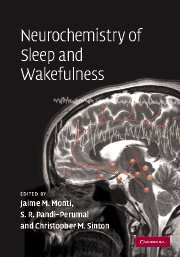Book contents
- Frontmatter
- Contents
- List of contributors
- Preface
- Acknowledgements
- Abbreviations
- I The neurochemistry of the states of sleep and wakefulness
- II The influence of neurotransmitters on sleep and wakefulness
- III Changing perspectives
- 10 Melatonin and its receptors: biological function in circadian sleep–wake regulation
- 11 Sleep regulatory factors
- 12 Adenosine and sleep–wake regulation
- 13 Prostaglandins and the regulation of sleep and wakefulness
- 14 Neuropeptides and sleep–wake regulation
- 15 Orexins in sleep and wakefulness: rodent models of narcolepsy–cataplexy
- 16 The relevance of experimental pharmacology to currently available sleep–wake therapeutics
- Index
- Plate section
12 - Adenosine and sleep–wake regulation
from III - Changing perspectives
Published online by Cambridge University Press: 23 October 2009
- Frontmatter
- Contents
- List of contributors
- Preface
- Acknowledgements
- Abbreviations
- I The neurochemistry of the states of sleep and wakefulness
- II The influence of neurotransmitters on sleep and wakefulness
- III Changing perspectives
- 10 Melatonin and its receptors: biological function in circadian sleep–wake regulation
- 11 Sleep regulatory factors
- 12 Adenosine and sleep–wake regulation
- 13 Prostaglandins and the regulation of sleep and wakefulness
- 14 Neuropeptides and sleep–wake regulation
- 15 Orexins in sleep and wakefulness: rodent models of narcolepsy–cataplexy
- 16 The relevance of experimental pharmacology to currently available sleep–wake therapeutics
- Index
- Plate section
Summary
Introduction
The timing and amount of sleep is regulated by two main processes in order to optimize for the survival of the individual. A circadian process, driven by the internal clock in the brain, facilitates wakefulness at those times of the day when activity and foraging are possible, and facilitates sleep at those times when it is dangerous to leave the abode, or difficult to find nourishment. A homeostatic process ensures that the proper amount of sleep is acquired, according to the specific needs of the species and the individual. Insufficient sleep will cause “sleep pressure”, which is expressed in increased propensity for sleep. If sleep is delayed, e.g. by activity, the accumulating sleep pressure will eventually result in “recovery sleep”, characterized by increased duration and intensity, when sleep is again possible. To some extent the opposite is true: previous oversleeping may reduce sleep pressure to reduce sleep time. The interaction between these processes to regulate wake–sleep behavior has been formulated in Borbély's two-process theory (Borbély, 1982), the main tenet of which is still valid today. Adenosine has been shown to play a part in the homeostatic process, and this chapter will review that role.
As early as in 1909, it was recognized that some chemical factor in the brain was responsible for recovery sleep.
- Type
- Chapter
- Information
- Neurochemistry of Sleep and Wakefulness , pp. 337 - 362Publisher: Cambridge University PressPrint publication year: 2008
- 2
- Cited by



